Week 5 CSA Farm Newsletter (July 16-23, 2023)
Farm Newsletter Week 5
July 16-23, 2023 | “A” Week
What’s in the Box this Week?
GOLDEN BEETS ~ These beets have a gorgeous gold interior. They are best showcased in conjunction with their partner red beet. To store: If your beets still have greens attached, cut them off, leaving an inch of stem. Store the beet roots, with the rootlets (or “tails”) attached, unwashed, in a plastic bag in the crisper bin of your refrigerator. They will keep for several weeks. To prep: Just before cooking, scrub beets well and remove any scraggly leaves and rootlets. If your recipe calls for raw beets, peel them with a knife or a veggie peeler, then grate or cut them according to the recipe. To remove the skins, you can roast them in foil or boil them, and the peels will slip right off. To freeze: Boil or bake beets until done. Cool them in ice water or let them come to room temperature. Remove peels. Trim the beets into 1/4 inch slices or keep them whole (if they are small). Place in Ziplock freezer bag and remove as much air as possible. Seal and freeze.
GREEN KOHLRABI with tops ~This plant was developed by crossing a cabbage with a turnip! The edible part of the plant is an enlarged section of the stem that develops just above the ground. It has a crisp interior like a potato. Store kohlrabi globe and leaves separately. The bulb will last for 2 weeks refrigerated in a plastic bag. Wrap leaves and stalks in a plastic bag and keep in the crisper drawer of the refrigerator. To prep: Rinse under cold running water just before use. Cut the outer skin off with a knife. Trim off the remains of the stalks and root. Grate, slice, or chop as desired. To cook: Cut raw kohlrabi bulb into sticks for a refreshing addition to a raw vegetable tray or grate it for salads. Try raw kohlrabi smeared with peanut butter. Lightly boil, steam or bake it, or add it to stews and stir-fries. Young kohlrabi leaves can be used in recipes calling for greens. To freeze: Cut into cubes or slices and blanch for 3-4 minutes. Place into ice water bath to stop the cooking. Drain and dry. Place in Ziplock freezer bag.
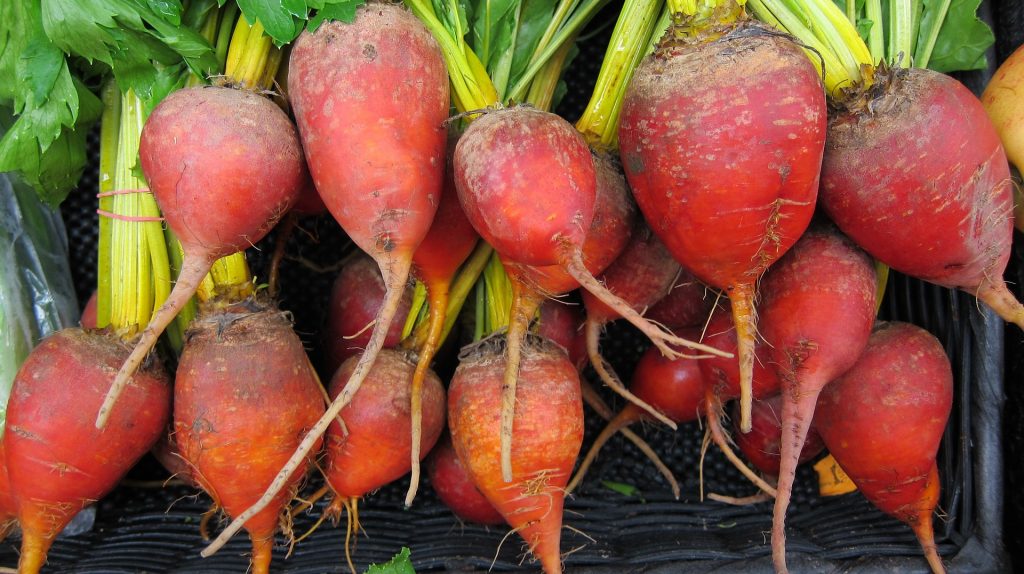
Golden beets are orange inside.
RED SALAD TURNIPS with tops (1 bunch) ~ Turnips are a root vegetable. They are best in the fall or spring, when they are small and sweet. To store: Remove the greens from the turnips and store in a plastic bag to use within 3 days. The turnip roots should be stored in a plastic bag in the crisper drawer of your fridge for up to a week. To prep: Cut off the green tops (which can be eaten as well). Wash and cut the roots into wedges or slices. To cook: Serve raw with dip in a veggie tray. Or grate and add them to a salad. Turnips are delicious when roasted with other root vegetables (like carrot, potatoes, rutabaga, garlic). Add a turnip or two to your favorite mashed potato recipe. Or add them into soups and stews. To freeze roots: Blanch for 3 minutes in hot boiling water. Cool in ice water for 3 minutes, drain and pack into freezer containers or freezer bags.
LONG RED TROPEA ONIONS (1 bunch) ~ These onions are often called “torpedoes” at our farm, due to their torpedo-like shape. Because they are not cured, these fresh onions will need to be stored in a plastic bag in the fridge and use within 2 weeks. To prep: Peel the onion’s skin and cut off the roots and top. To freeze: Cut or slice onions to desired size and place in freezer Ziplock bag. Remove all the air and seal. It helps to freeze them in 2-3 cup increments.
SWEET AILSA CRAIG ONIONS (1 bunch) ~ We’ve loaded you up on onions for the next two weeks! Use the tops like you would for scallions. The bulb should be separated from the greens and stored in the fridge, as it is not cured. Peel the outer skin and roots.
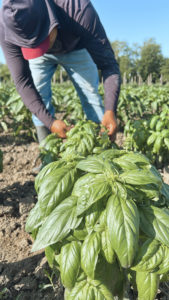
DINOSAUR KALE (1 bunch) ~ To store: Place kale unwashed, wrapped in a sealed plastic bag in the crisper drawer of the refrigerator. Best used very fresh, but may last for a week. To prep: Wash leaves in basin of lukewarm water to remove grit. If your greens have thick stems, you must remove them. Fold each leaf in half and slice out the stem. Then stack the leaves up and slice them diagonally into 1-inch-wide strips. To use: Saute in olive oil. Use in soups, spaghetti sauce, pesto, quiche, or kale chips. You can also eat the stems. To freeze: Blanch washed greens for 2-3 minutes. Rinse in cold ice water to stop the cooking process, drain, and pack into airtight containers. Stems can also be frozen.
BASIL (1 bunch) ~ To store: Basil is very sensitive to cold. Do not refrigerate fresh basil; it will turn black. Instead, strip the lower leaves off the stems and place stems in a glass of water on the kitchen counter like a flower. To prep: Mince well. Add to butter, cream cheese, or your favorite pasta sauce. Make a batch of pesto with pine nuts, Parmesan, olive oil, salt, and garlic. To dehydrate: Remove leaves from stem and place on a piece of paper towel on a glass plate. Cover with another piece of paper towel. Microwave plate on high for 1 minute. Leaves will be dry. Crinkle them with your finger and place them in a dry container, such as a Mason jar with a lid. To freeze: Basil does not freeze well. Instead, make a batch of pesto and freeze it flat in Ziplock bags.
HEAD LETTUCE ~ Store unwashed lettuce in a Debbie Meyer Green bag or Tupperware FridgeSmart container in the refrigerator. To store lettuce that you have already washed and dried with a spinner, place back in a plastic bag with a dry paper towel in the bag, and place the package in the vegetable crisper bin. Use within 4 days. To prep: Wash leaves in a basin of cold water. Dry in a salad spinner. To freeze: Not recommended.
WEEK #5 ADD-ON SHARES: We are Week “A”
Odd-numbered weeks of our CSA season (week 1,3,5) are called “A” weeks. And even-numbered weeks (week 2,4,6) are called “B” weeks. If you have any kind of non-veggie, bi-weekly share, you have been assigned to either “A” or “B” week for the season. If you get a cheese share, it always comes on Week “A.”
WEEK 5 FRUIT SHARE:
PEACHES ~ (via Quarry Hill Orchard) – if these are hard as a rock, you’ll want to store them on the counter until they ripen. THEN put them in the fridge.
BLACKBERRIES (Mark Maag Farms) ~ These are highly perishable. Eat within 3 days. You should rinse them before eating. Try rinsing in a vinegar bath and then air dry to give them longer shelf life. Store in fridge.
CUSTOMER PHOTO OF THE WEEK!
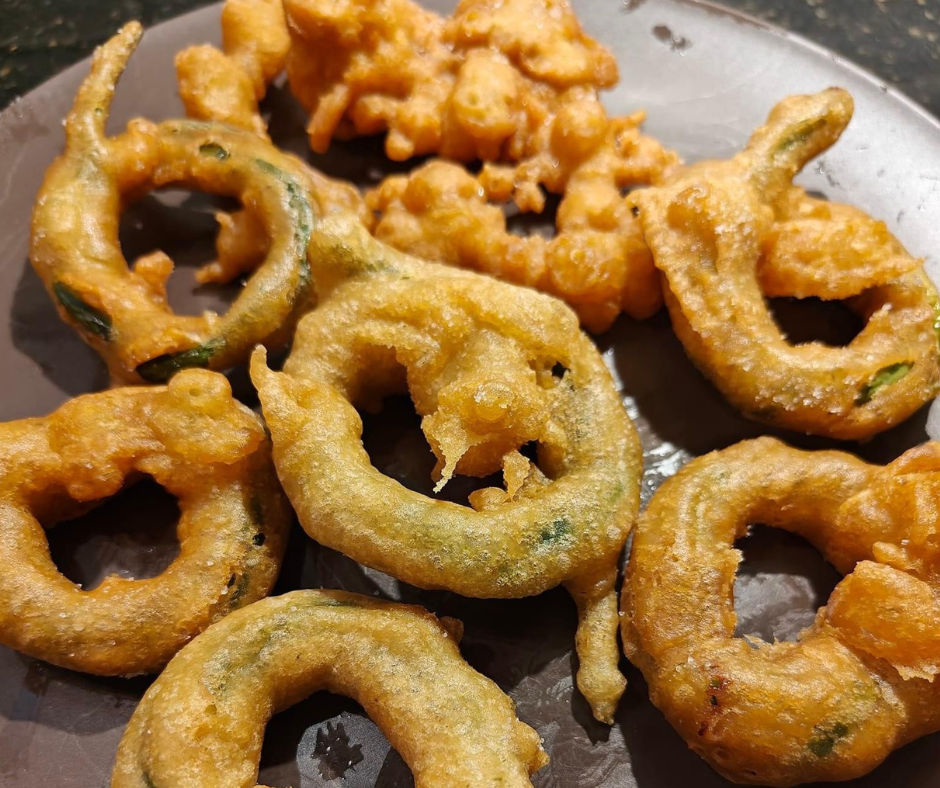
Clara Eckel made tempura garlic scapes. These lit up the Facebook group!
Our thanks to Clara Eckel for winning this week’s Photo of the Week. She made tempura-battered garlic scapes, and it caused lots of other folks to try this out. I even saw someone make tempura radishes. Thanks for inspiring our community with cool ideas like this one. (We also liked the Beet Bagels idea. It was a close second).
Cheese Share:
Charloe, Canal Junction Farmstead ~ A beautiful washed rind cheese with an edible orange-hued rind. It has a smooth, creamy texture and an assertive taste. Charloe starts off with sweet cream and butter flavors and finishes with an essence of toasted peanut (no peanuts added) and semi-sweet chocolate. This award winning cheese pairs perfectly with stout beer, a crisp white wine.
Black Swamp Gouda, Canal Junction Farmstead ~ Buttery and smooth is how many describe it. Delicious on sandwiches or paired with fruit for a flavor-packed snack. It is aged 2-4 months and best paired with lagers, pale ale, IPA, merlot, chardonnay, and cider. Milk comes from our Normande cows. Milk from Normande’s is known world wide for its ability to make excellent cheese because of its protein/casein properties.
Cognac Fig Chevre, MacKenzie Creamery — one of our customers’ favorites. This cheese has won numerous awards, including 1st place in its category at the 2018 World Championship Cheese Contest and multiple awards from the American Cheese Society. Simply open and unmold this cup upside down to let the cognac fig sauce coat our fresh chèvre. Ingredients: Pasteurized goat milk, cognac, fig (figs, sugar, pectin, citric acid, lactic acid, ascorbic acid), salt, culture, microbial (vegetarian) rennet.
Ice Cream Flavor of the Week:
EGG NOG from Knueven Creamery. Note: be sure to stop and pick up your ice cream from the Knueven milk truck at your pickup site! They will be located either right before or after your veggie pickup. Your farmers will not be passing this out in their delivery line.
Coffee Flavor of the Week:
ETHIOPIA HARRAR: Maddie & Bella Coffee Company ~ bright blueberry, wine, hint of cocoa
Why the US Declared War on Currants and Gooseberries in 1911
Did you know that 99.9% of Americans have never tasted a currant or gooseberry?
Yet in western Europe (especially England and Germany), they are extremely popular in the form of sauces, pies, crumbles, and jams. They are prized for their nutritional density and medicinal properties, too. I’ve often wondered why it is that no one seems to know what these are when I sell them in our store every year.
This week, I learned the reason:
For half a century, the US government conducted a “domestic war” on currants and gooseberries. Today I wanted to tell the misunderstood history of this culinary delight by sharing a quick overview of why these berries have been largely overlooked in the United States for the last 100 years. This is a fascinating story of how history and public policy can affect our food exposure.
I’m hoping it will make you want to try the gooseberry!
Let’s start with the basics. Gooseberries and currants belong to the Ribes genus and come in various species and flavors. Gooseberries are a crisp berry – usually tangy and slightly sweet, while currants offer a delightful balance of tartness and sweetness. Currants come in different colors, including red, white, and black, each with its unique flavor profile.
Now, you might be wondering why these berries aren’t as popular in the United States compared to countries in Europe. Well, although gooseberries and currants were brought over by early European settlers, they ran into a bit of a snag….
One major setback for these berries was the arrival of a fungus in 1909 known as white pine blister rust, which threatened the precious white pine stands, an important timber tree in the US. Turns out that gooseberries and currants are the alternate hosts for this specific fungus, and they were seen as potential carriers. To protect the pine industry, any currants and gooseberries within 300 feet of white pine trees had to be destroyed. As a result, currants and gooseberries were blacklisted in 1911. Millions of bushes were destroyed. Suddenly, it was illegal to grow them anywhere in the United States.
(Interestingly, the popularity of gooseberries and currants in Europe ran so deep that they were willing to make the opposite choice. When the white pine blister rust fungus affected their forests, Europeans chose to prioritize the gooseberries and currants, sacrificing the white pine stands in the process).
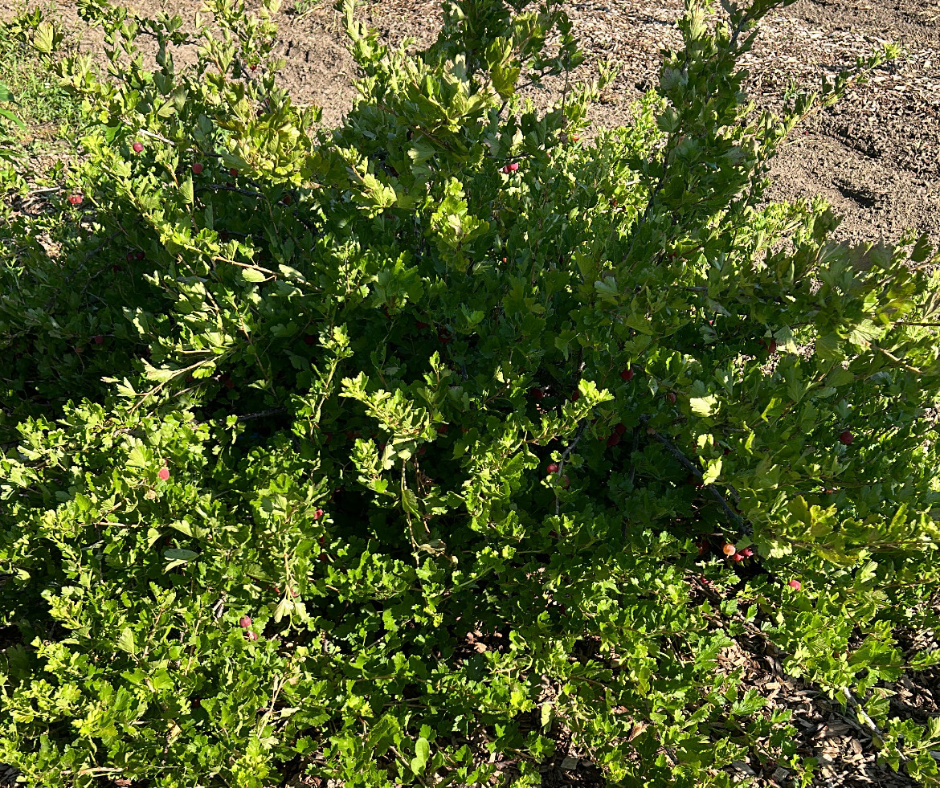
This is what a gooseberry shrub looks like.
As generations went by, Americans “forgot” about their love affair with the gooseberry and currant. It disappeared from the public’s consciousness and culinary diet.
Over time, however, as more knowledge and research became available, it was realized that certain cultivars of gooseberries and currants were resistant to the fungus and did not contribute significantly to its spread. As a result, in the mid-1960’s, many states started to lift the bans and adopt regulations that allowed the cultivation and sale of specific cultivars that were deemed safe.
For more information on the history of the gooseberry, be sure to check out the insightful video shared by CSA member Brian Hammer last week in our Facebook group:
Today, the regulations regarding gooseberries and currants vary by state. While some states (like Maine and New Hampshire) may still have restrictions or specific requirements to prevent the spread of white pine blister rust, many have lifted the bans or have relaxed regulations, allowing the cultivation and enjoyment of these delightful fruits. You can visit this website to see what states still have bans in place (and for what species).
So, my fellow foodies, it’s time to discover the wonders of gooseberries and currants – which have been forgotten by our prior generation! Give these berries a chance! They are amazing. From jams and jellies to pies and sauces, fools, scones… I’d love to see you lead the way and help our local Toledo community rediscover these berries.
You’ll find them in our online store this week for the last week this season.

Kurt installs evaporators in the new cooler with the help of Yackee Electric
FARMER KURT’S FIELD NOTES
This week, I’ve been working on the cooler install! No, the big, big cooler still isn’t operational. The condenser unit finally arrived two weeks ago. But I had a devil of a time finding someone to be able to come out and install it. Everyone I called told me ,”I can get you in sometime in September…” Luckily my cousin’s company was able to come out and look at the project. He had some time next week to squeeze me in. (My wife would say I just fall into this stuff). I’ve also reached out to my electrician Yackee, so we’ll be bending wire and pulling electrical out to that part of the pack shed this weekend. And not a minute too soon! The sweet corn will be coming in next weekend! And that means we’ll need the cooler space. I don’t know how we’ve been able to make it work so far!
My neighbor Downsy cut our rye yesterday. I called around trying to find someone with a combine (and a wagon) who could come out and do it for me. I have such a small acreage, that it can be tricky to get someone willing to do it. He cut that field for me in under an hour! I’ll save some of that seed to replant. And some of it will be ground up for our rye flour that we sell. Rye is a great cover crop for us. It adds nutrients back into the soil and keeps it from becoming depleted. My boys are glad it’s gone, because apparently it’s hard to fly RC airplanes because stuff can get lost in the rye field.
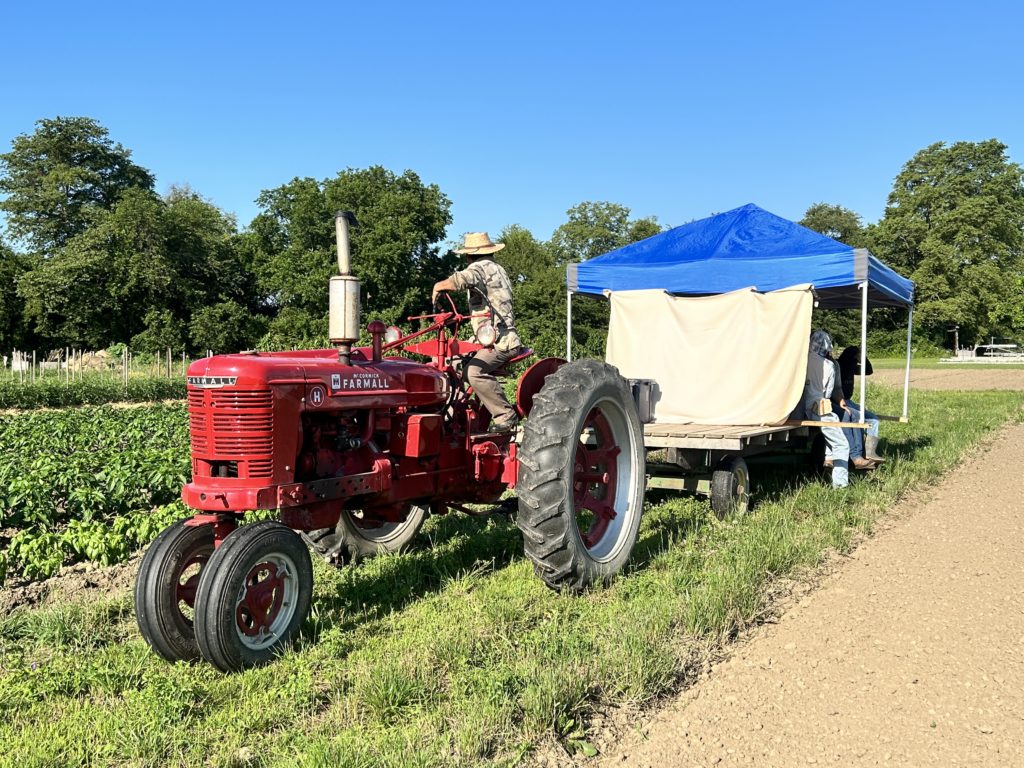
I rigged up a canopy tent and put it on my wagon for shade.
My crew rigged up a shade canopy for one of our wagons this week. It was really hot on Monday — I mean REALLY hot, already at 9 AM. It’s inefficient for my team to drive or walk back the greens one at a time into the cooler. But those crops will just wilt if I don’t get the field heat out of them quickly, or get them into some shade. I just haven’t gotten around to building a shady canopy over my wagon yet. So I got some wooden beans, laid them cross the back of the wagon, and then hammered in one of my site host tent legs into the boards. We propped that sucker on the wagon, and it worked great. Plus, it’s a nice place to cool off for the crew, and keep their water.
Glen is making me a new metal trailer. We’re taking the bed off an old tomato trailer from my dad, and putting it onto a new frame. Should be ready by next week. I’ve got a shortage of wagon/trailers, so this should help.

Cadie Jardin (our CSA Coach) was away this week at a national championship for weightlifting. She earned 2nd place!
Cadie (our CSA Coach) is now a celebrity. She placed at NATIONALS for weight-lifting. <== That’s right. She set 3 new state records for her weight/age class in squat/bench/deadlift, and earned second at nationals for her weight/age. Must be all those vegetables….? We’re so proud of her, and wanted to make sure we celebrated that achievement.
I got my fall crops planted early this week. Cauliflower and fennel went in on Saturday. It’s hard to believe that I’m already planting things for the fall months, when summer has just started, right? My boys did some awesome weeding in the peppers this week too. As long as I stay on top of it in the early stages, I’m okay. There does come a point when I let the weeds come — when I’ve exhausted most of the plant’s life. But it’s such a moment of satisfaction to see clean beds. The one big exception is the onion patch. It’s pretty grassy. But I think most of the bulbs are almost to size, so it should be okay.
The heirloom tomatoes in the high tunnel are turning. We had the first one as a tomato sandwich. Wow, I’m excited to share them with you soon! Jed spent an hour picking three black crates of them today. I also had him cultivate watermelons for me. He is so good at tractor work. Jed also snuck away this week for a couple hours — no one knew where he had gone. He returned to the kitchen bearing 3 peck baskets of raspberries — handpicked by him. He then proceeded to make a batch of berry freezer jam. Who is this kid?!!
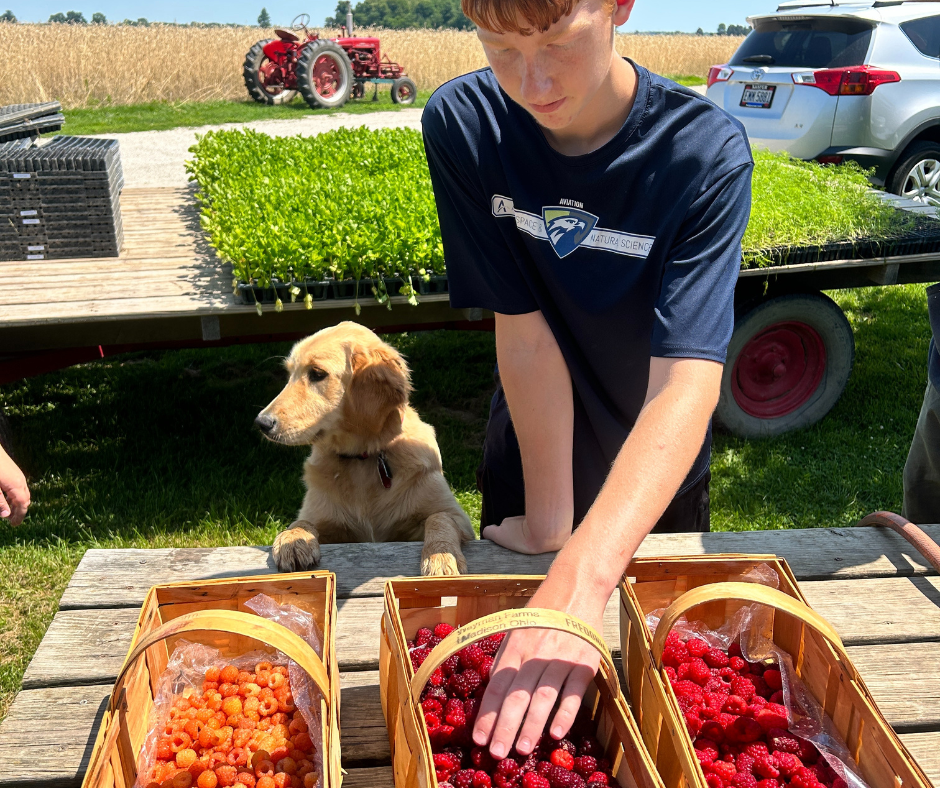
Jed disappeared for 2 hours and came back with these raspberries!
We’re running into a bit of a traffic congestion issue at the Sylvania site. I sent out an email this Wednesday to members at that site to offer some suggestions for how we can get cars off the road as soon as possible. Apparently the Jewish Temple has been called twice now by law enforcement, complaining about the traffic jam our line is creating at the light on Sylvania. I feel really bad about it. Corinna and I are also looking at moving the site long-term to a different location in Sylvania that isn’t on such a busy road. If you know of a great place (with a lot of open space, that isn’t busy), or if you have a connection with the business/location (even better), please reach out to us. Perrysburg is also pretty crowded, but our email to you guys appeared to do the trick, as this past Thursday, we had a noticeable difference, and it went PERFECT. Let’s keep it up! Thanks for working through our growing pains.
The Facebook group is blowing up this year. Great work everyone, sharing your ideas. I see a lot of energy and crowd-sourcing. It feels great to see us being a community.
NEXT week, I’m taking my family on a mid-season vacation. We’re going to the Red River Gorge. (Kudos to Elizabeth Tore who suggested it). We’ll be staying in an AirBnB in Easter Kentucky, doing lots of hiking, and probably a canoe trip underground. I’m also hoping to do some “sitting around” and napping. We’ll be gone July 23 through 28, and won’t be available via email or phone. So clean out your fridges, and come back hungry on Week 6! I’ll have sweet corn for you.
~Your Farmer, Kurt
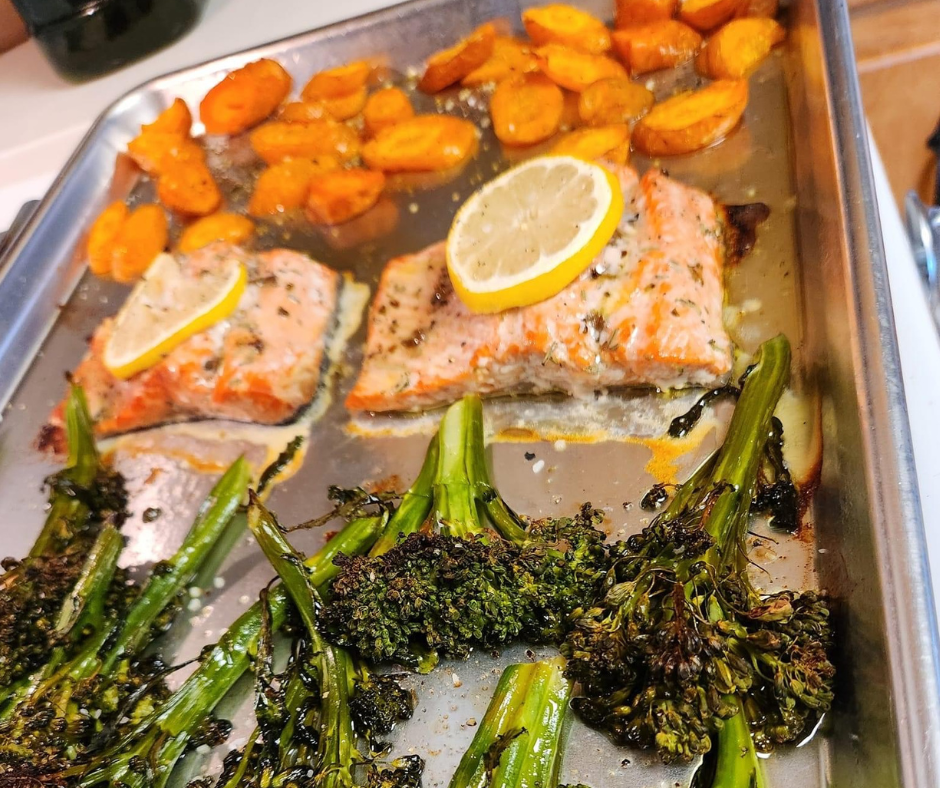
Danielle Kuhl made this sheet pan meal with Citizen Salmon Alaska salmon, carrots, and broccolini
WEEK 5 ANNOUNCEMENTS
Your farmers are going on vacation June 22-28! That means there will be NO CSA PICKUP in a week. Don’t worry. We simply “pause” CSA for a week and restart it August 1. Week 6 (which is B Week) will re-commence on August 1st.
- LAST CHANCE TO ENTER SLF BINGO! Contest ends Friday. From July 1 – July 21, you are encouraged to compete in our SLF Bingo Board competition. Download this PDF file of our Bingo Board. Fill in as many of them as you can over the next 3 weeks! Some of them are EASY (you may already have done them), and some are little more challenging. Once you complete 20 of the 25 spots, post a picture of your Bingo board in our Facebook group with the hashtag #CSABingo2023, or send me an email that you’ve completed it. I’ll choose 2 random winners from this pool of submitted boards on July 22nd, and you’ll receive a box of baked goodies from the Occasional Baker!
- Farm Dinner for June 29th is sold out. That was fast! Details will be emailed to you from Katie and Chef Joseph!
- Shop Our Online Store This Week for More Goodies: Our store link is super easy to remember: www.sharedlegacyfarms.com/store. Just be sure to select the right pickup site that coincides with your pickup location. If the pickup option is greyed out or not available, it means you missed the window to order. You need to place your order 36 hours before your site. We harvest the product on Monday and Wednesday mornings — early. This week, the store will have: orange carrots, 1.5# (no tops), purple gooseberries (On SALE, final week), Jed’s raspberries (only 50), peaches by the quart, heirloom tomatoes (first of the season, very limited), red beets, chioggia (bulls-eye) beets, gold beets, Ailsa Craig sweet onions, red long tropea onions, hakurei turnips (no tops), small arrowhead cabbage, Swiss chard, curly kale, garlic scapes (On Sale, CLEARANCE!), SLF trucker hat merch, SLF swag stickers, honey, and maple syrup.
- If you’d like to get on the wait list for BULK BEETS for canning or preserving, please reach out to me via email. The price is usually $22 for a peck basket of beets. No tops.
- BULK CORN – When we get back from vacation, we should have sweet corn available for bulk purchase or in half-dozen/dozen bags.
- Sylvania customers: we are asking you to please wait to arrive to the pickup site until 5:15 PM at the earliest, due to traffic congestion causing safety concerns on Sylvania Ave. Farmer Kurt will play Traffic Cop this week, and show you where to line up (and in some cases park) to make sure the road stays clear. Please help us by not coming early to wait in line, and by considering coming later in the pickup hour when we have fewer lines. We’ll see how this goes next week. If you have some other suggestions for pickup locations, we are all ears, especially if you are local to Sylvania.
- SALMON FROM CITIZENSALMONALASKA.COM is now shipping orders. Place your order for salmon, halibut, or scallops now at www.CitizenSalmonAlaska.com. You can order ANY time of year while supplies last. The fish is SUPER fresh — processed and blast-frozen within 5 hours of the catch. Aaron processes it into smaller cuts (individual portion sizes) and each portion is vacuum-sealed. It arrives frozen on your doorstep, or your money back. And you’ll get a notification from Aaron once it’s shipped so you can keep track of its progress.As a CSA member you get a 5% discount on ALL online orders with CitizenSalmonAlaska.com through December, 2023. Use the coupon code we gave you in your email. Note that the price of overnight FedEx shipping is included in the cost you see per pound on the website. You get a significant savings the more fish you buy. So a 40 lb. order of salmon will be much less than a 15 pound order.
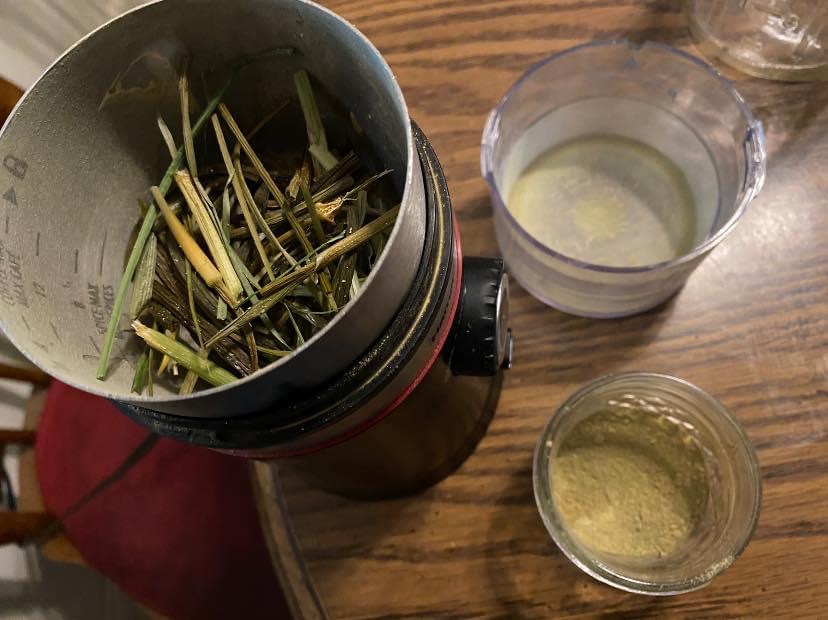
Michelle Perkins Cole shared a hack for dehydrating garlic and making garlic powder.
How to Plan Your Freezer Stash So You Have CSA Food Year Round
by Cadie Jardin
A few weeks ago a member posted a great question in our Facebook group that sparked some great conversation.
“How do you plan/prioritize your freezer stash to be able to have CSA food year round?”
There were some comments from other members but we wanted to take some time to answer this in a longer post.
Looking back at my experience over the years, and gathering other CSA members thoughts, these are some strategies for you to consider.
- Learn what CANNOT be preserved easily and make sure to enjoy those things during the CSA season. Make those things on your priority list each week. Changing your mindset to “what needs to be eaten first” vs “what do I want to eat this week” can be helpful.
2. Learn what CAN be preserved/frozen easily. There are different preservation methods: canning, drying and freezing, the easiest and most common being freezing. Members who have learned what they can “throw in the freezer” have found this to be a game changer.
3. Take note of any “bag and freeze” items in your box each week. These are things that don’t need to be blanched or need additional prep. They can simply be frozen whole or chopped in a freezer safe bag. Our newsletter often tells you this, as well as the weekly unboxing videos. Common things like peppers, onions, garlic and even tomatoes are on this list. Our members love to make “fajita bags” by slicing peppers and onions so they have them ready to go in the winter!
4. Have some extra time? Learn what can be frozen with some extra work, maybe something can be frozen if you blanch it. The most popular thing our members freeze by blanching are the greens (so many veggie tops in addition to things like chard and spinach). If you know you have some in your fridge that you want to freeze, store them well and see if you can gather the next weeks greens to add to that batch. This saves you time and gets even more into your freezer.
5. Sometimes freezing vegetables means making a freezer meal. This one is a real winner because it allows you to enjoy your veggies later and saves you time! These may be meals that you specifically make for your freezer, or something that you batch cook during your usual dinner routine. Things like stuffed cabbage or peppers, sauces, soup bags, casseroles and enchiladas are some easy go to meals that freeze well. A great question to ask yourself when you’re making a meal is “can I make extra and freeze some?”
6. Embrace overload weeks. Get comfortable with the flow of the season; know that you will get repeat veggies sometimes week after week. Don’t think you need to consume all of them that week, learn how to freeze those items and embrace it. Most of the items that “overload” us are things that freeze well (corn, peppers, tomatoes, etc). Pepperpalooza each year used to stress me out and now I can’t wait to get those gems in my freezer for winter!
7. Freeze in pre portioned amounts when you can. Have some favorite recipes or go to portions you like to use? Freeze things in small amounts. You can always take more from the freezer, but if you have an entire zip lock of pesto it’s harder to get the portion you want. Freeze things in pucks or cubes, or the volume you want. Have a go to zucchini bread recipe? Freeze that zucchini in that amount so you can simply grab some when needed!
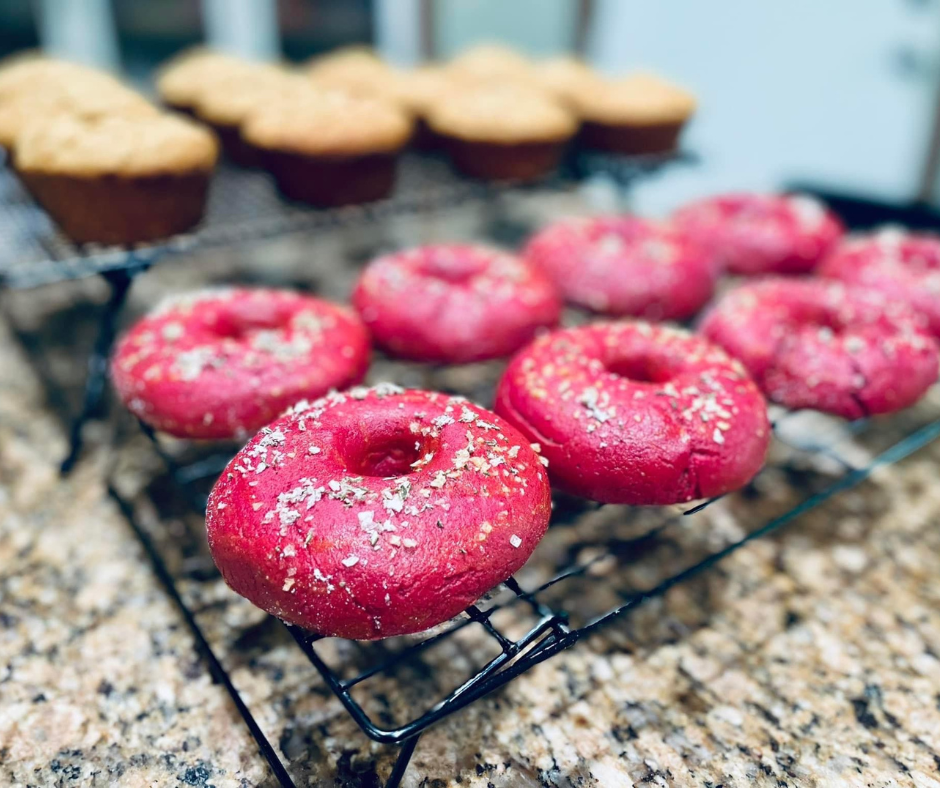
Kate Lynn baked these beet bagels, which were inspired by Clara Eckel’s post. This recipe was tried by several CSA members this week.
WEEK 5 CSA RECIPES
Members: You can download these recipes as a PDF here. These recipes are designed to inspire you to use your box this week! Please check inside our private Facebook group to find your fellow members sharing ideas for what to make with their box! Share a photo and you might be featured in next week’s newsletter!
Basil Vinaigrette
Basil Pesto
Crispy Apple and Kohlrabi Salad
Sautéed Kohlrabi, Onions and Basil
Balsamic Glazed Grilled Sweet Onions
Quick Pickled Beets and Onions
Summer Squash Lasagna
Summer Squash Tart
Roasted Beet Hummus
Shaved Turnip and Radish Salad with Poppyseed Dressing
Spiced Chickpeas with Wilted Kale and Roasted Carrots
Grilled Tropea Onions
Peach Blackberry Crumble
Gooseberry Mustard Relish
Gooseberry Galette


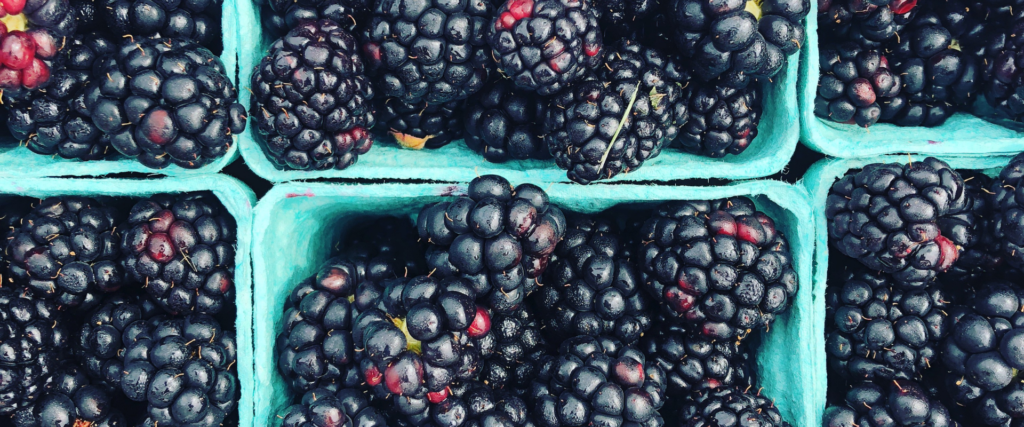
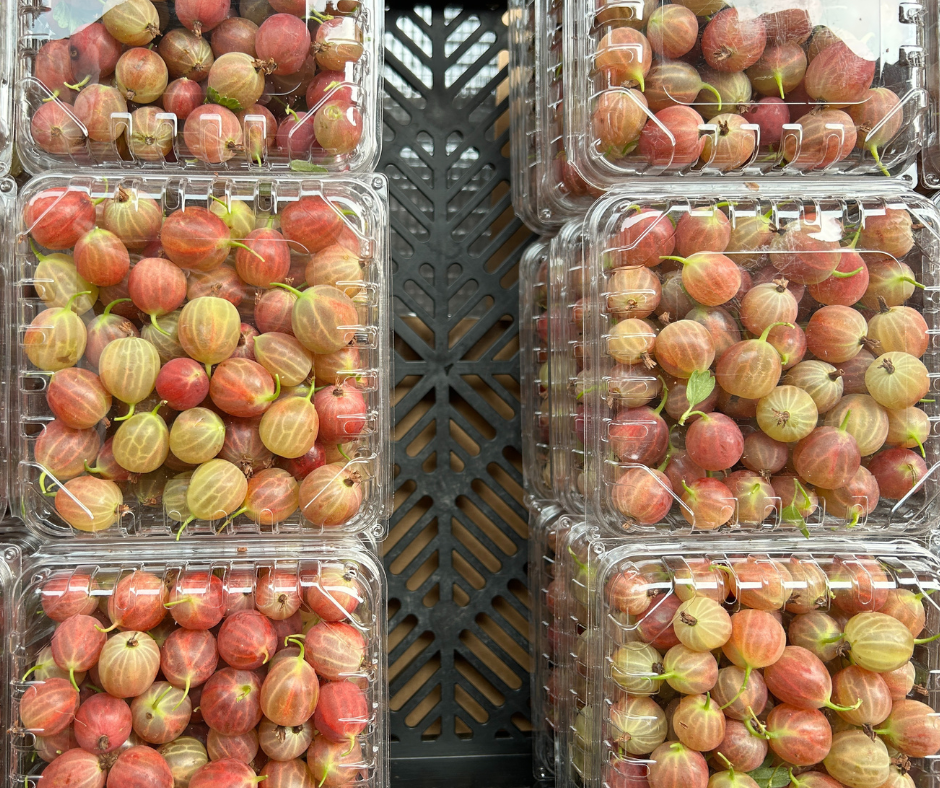
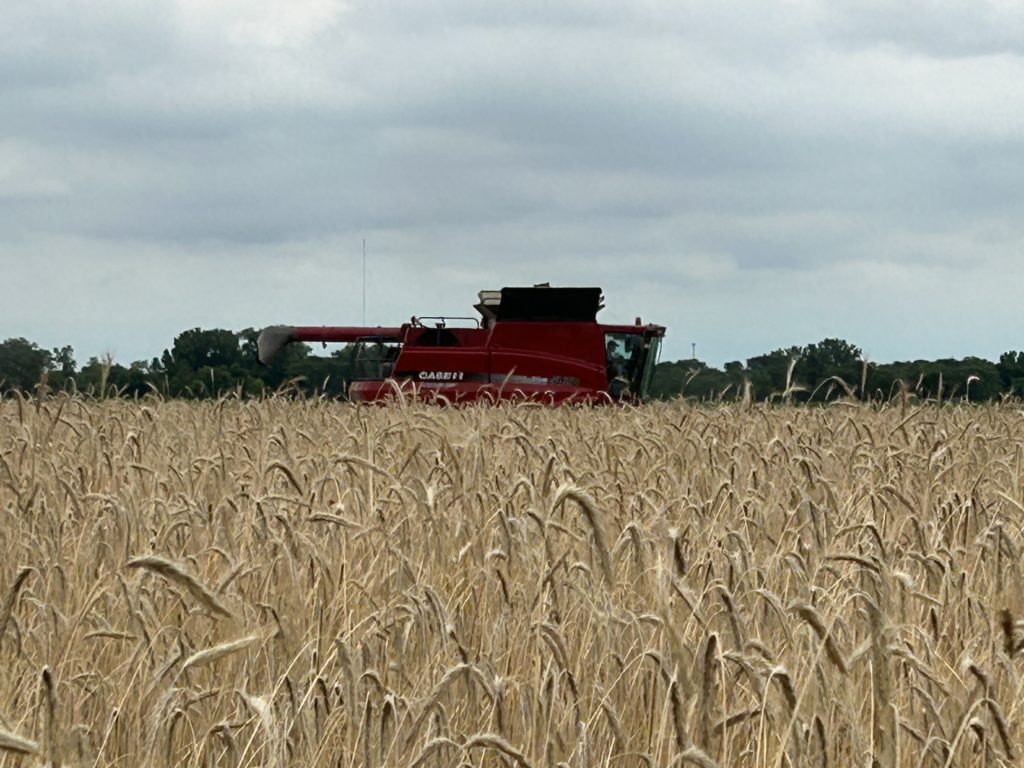
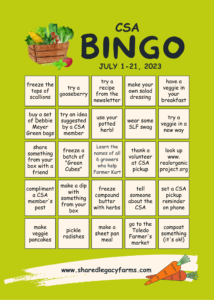 Your farmers are going on vacation June 22-28! That means there will be NO CSA PICKUP in a week. Don’t worry. We simply “pause” CSA for a week and restart it August 1. Week 6 (which is B Week) will re-commence on August 1st.
Your farmers are going on vacation June 22-28! That means there will be NO CSA PICKUP in a week. Don’t worry. We simply “pause” CSA for a week and restart it August 1. Week 6 (which is B Week) will re-commence on August 1st.